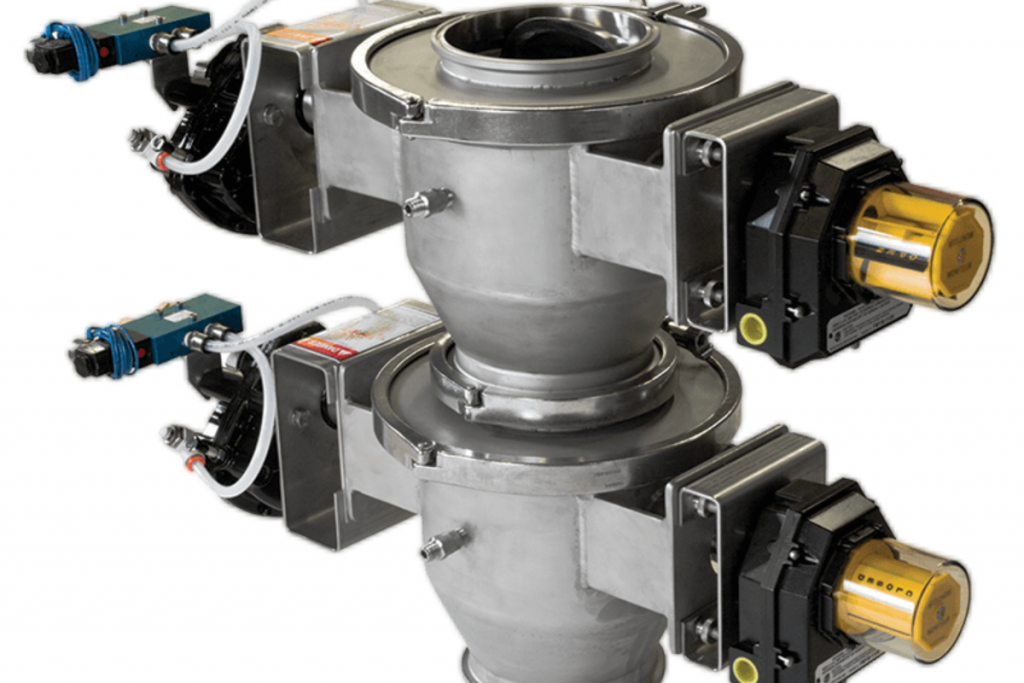
Precision is paramount. In this comprehensive guide, we’ll navigate through the steps of sizing a pneumatic conveying system, ensuring you achieve seamless material handling tailored to your requirements.
Step 1: Define System Requirements
First, define the system’s requirements to begin sizing a pneumatic conveying system. Material properties are pivotal – understanding bulk density, particle size distribution, moisture content, and abrasiveness is key.
Thoroughly calculate the material flow rate, expressed in pounds or kilograms per hour, and consider the conveying distance, factoring in any vertical or horizontal changes in direction.
Step 2: Select Conveying Mode
The choice between dilute-phase and dense-phase conveying modes sets the foundation for system design. Evaluate material characteristics to determine the most suitable method.
Related Post: Roto-Flate® Failure Mode Enhancements Increase Efficiency of Your Processes
Dilute-phase offers high material-to-air ratios and is ideal for lighter materials, while dense-phase is the go-to for heavier, more abrasive substances.
Step 3: Calculate Air Requirements
Achieving optimal material flow requires a precise calculation of air requirements. Determine the conveying air velocity based on material characteristics.
Calculate the system’s pressure drop, factoring in bends, elbows, and other components. This forms the basis for selecting the appropriate air compressor or blower.
Step 4: Choose Conveying Pipeline Components
Carefully select the pipe diameter based on material flow rate and air velocity. Opt for smooth bends and elbows to minimize pressure drop. The choice of an air source, be it a compressor or blower, should align with the required air pressure and flow rate.
Step 5: Design Material Feeding and Discharge
Efficient material handling hinges on the design of material feeding and discharge mechanisms. Your company must select feeding devices – rotary valves, screw feeders, or others – based on material characteristics.
Simultaneously, choose discharge equipment like rotary or diverter valves to control material flow at the destination precisely.
Step 6: Consider Material Degradation and Wear
Material degradation can impact product quality and system longevity. Conduct a thorough evaluation of the material’s susceptibility to degradation.
Choose system components that minimize this risk and implement wear protection measures, such as abrasion-resistant liners and coatings.
Step 7: Factor in System Controls and Monitoring
Integrate automation and control systems to monitor and adjust critical parameters, including material flow rate and air pressure. Safety features must be incorporated to prevent overpressure or material blockages, ensuring a safe operating environment.
Step 8: Installation and Commissioning
The success of a pneumatic conveying system hinges on professional installation and commissioning. Enlist experienced professionals for installation, ensuring precision. During commissioning, thorough testing and adjustments should be made to fine-tune the system for optimal performance.
Step 9: Regular Maintenance and Monitoring
Establish a schedule for cleaning, inspections, and replacing wear-prone components. Implementing monitoring systems allows for real-time tracking of system performance, enabling interventions to address any deviations.
Sizing Examples
The examples below showcase the diverse considerations in sizing pneumatic conveying systems for different materials and operating conditions.
Related Post: Pneumatic Conveying Systems Beginner’s Guide
Tailoring the approach to specific requirements is crucial for achieving optimal performance and efficiency.
Example 1: Sizing for Light, Free-Flowing Material in a Dilute Phase System
Material Characteristics:
- Material: Plastic pellets
- Bulk density: 30 lb/ft³
- Particle size distribution: Small and uniform
- Moisture content: Low
- Abrasiveness: Low
System Requirements:
- Material flow rate: 5000 lb/hr
- Conveying distance: 100 ft with minimal changes in direction
Steps Taken:
- Define system requirements: Gathered detailed information on plastic pellets, including bulk density and particle size distribution. Calculated the required material flow rate and considered the conveying distance.
- Select conveying mode: Opted for a dilute phase conveying system due to plastic pellets’ light and free-flowing nature.
- Calculate air requirements: Determined the conveying air velocity based on material characteristics and calculated the system’s pressure drop.
- Choose conveying pipeline components: Selected the appropriate pipe diameter based on the material flow rate and air velocity. Choose smooth bends and elbows to minimize pressure drop. Selected a suitable air compressor.
- Design material feeding and discharge: Choose a rotary valve for material feeding and discharge to ensure precise control over material flow.
- Consider material degradation and wear: Evaluated the material for degradation risks. Implemented wear protection measures as needed, such as abrasion-resistant liners.
- Factors in system controls and monitoring: Integrated automation and control systems to monitor and adjust critical parameters for optimal performance.
- Installation and commissioning: Enlisted experienced professionals for installation and conducted thorough testing and adjustments during commissioning.
- Regular maintenance and monitoring: Established a routine maintenance schedule for cleaning, inspections, and component replacement.
Example 2: Sizing for Heavy, Abrasive Material in a Dense Phase System
Material Characteristics:
- Material: Coal Ash
- Bulk density: 50 lb/ft³
- Particle size distribution: Varied, with larger particles
- Moisture content: Moderate
- Abrasiveness: High
System Requirements:
- Material flow rate: 3000 lb/hr
- Conveying distance: 200 ft with vertical changes in direction
Steps Taken:
- Define system requirements: Gathered detailed information on coal ash, including bulk density, particle size distribution, and abrasiveness. Calculated the required material flow rate and considered the conveying distance with vertical changes.
- Select conveying mode: Opted for a dense phase conveying system to handle coal ash’s heavier and more abrasive nature.
- Calculate air requirements: Determined the conveying air velocity based on material characteristics and calculated the system’s pressure drop, accounting for vertical changes.
- Choose conveying pipeline components: Selected the appropriate pipe diameter based on the material flow rate and air velocity. Considered wear-resistant components and chose an air blower suitable for dense phase conveying.
- Design material feeding and discharge: Choose a screw feeder for material feeding to handle the varied particle sizes. A diverter valve was selected for precise control over material discharge.
- Consider material degradation and wear: Conducted a thorough evaluation of material degradation risks and implemented robust wear protection measures.
- Factor in system controls and monitoring: Integrated advanced control systems to monitor and adjust parameters for optimal dense phase conveying performance.
- Installation and commissioning: Enlisted experienced professionals for installation, ensuring special attention to vertical conveying components. Conducted thorough testing and adjustments during commissioning.
- Regular maintenance and monitoring: Established a routine maintenance schedule, including inspections of wear-prone components, to ensure long-term reliability.
Contact Roto-Disc
Precision and attention to detail are your allies in achieving a seamless and efficient material handling process.
Contact Roto-Disc to learn how our valves can eliminate your valve headaches. We create customized solutions for a wide variety of industry applications.


